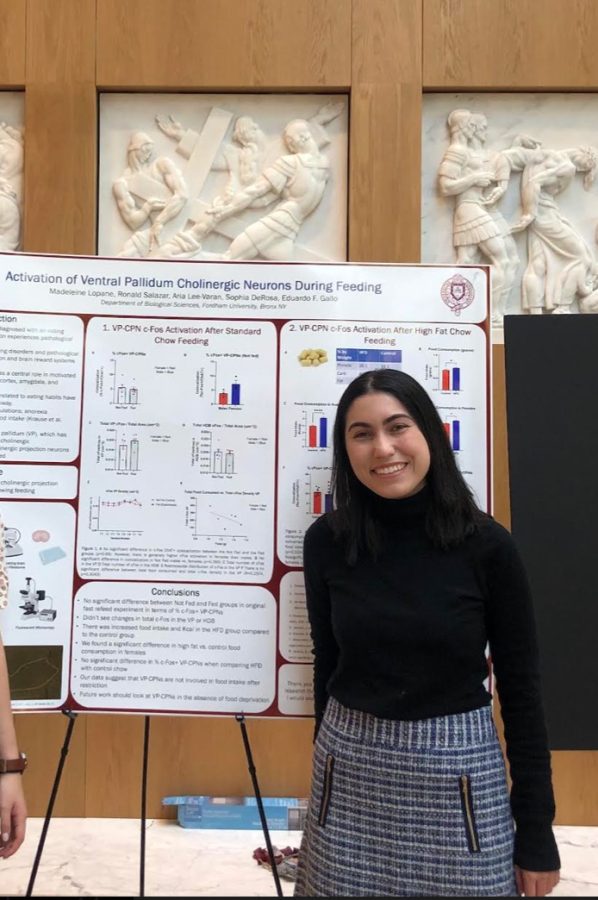Senior Researches the Neurobiology of Motivated Behavior
Madeleine Lopane, FCRH ’23, an integrative neuroscience major on the cell and molecular track, conducted neurobiological summer research with Eduardo Gallo, Ph.D. In her junior year, she began to study the neurobiology of motivated behavior, particularly in relation to reward seeking, which can have practical applications in issues such as substance abuse, ADHD and eating disorders. “I did some shadowing,” Lopane said, but eventually “I was able to develop my own project based off of my interests.”
She began the interview with some startling facts — 10% of individuals in the United States are diagnosed with eating disorders and 42% with pathological obesity. Lopane and many others believe these conditions are related to deficiencies in brain reward systems. “I wanted to look at these brain deficiencies and how they affect disorders,” she explained. Her research focused on the mesolimbic dopamine system, which is responsible for reward seeking and motivated behavior. One of the main pathways in this system is the ventral pallidum, which Lopane said has rarely been researched. There are three different types of neurons within this region, and for this project she chose to focus on cholinergic neurons. Lopane said these neurons utilize acetylcholine, which is very similar to nicotine, a known appetite suppressor. She said her primary objective was “to investigate whether ventral pallidum cholinergic neurons are activated following feeding.”
Lopane worked with a mouse population of 18 total mice split into two groups, a control group and an experimental group. Both groups of animals were deprived of food for 18 hours so that they had a similar baseline weight. After this fasting period, the control group was not fed the next morning, but the experimental group was fed with regular chow. Lopane was interested in determining whether hunger would lead to an increase in c-Fos, a transcription factor and neuronal marker, able to label a particular population of neurons when they are activated. “For instance,” Lopane explained, “if the mice were really hungry, and the food reward is very rewarding for that very reason, we suspected that there would be higher levels of c-Fos in this experimental group compared to the control group.”
Lopane collected food consumption and bodyweight data after running the experiment. She then used a machine called a vibratome which slices brain tissue to select regions of interest. “For me, it was the ventral pallidum,” Lopane said. She then conducted immunohistochemistry (IHC) which involves primary antibodies that are able to immuno-label for certain cells. Cholineacetyltransferace (ChAT) is an enzyme responsible for the synthesis of acetylcholine, and it can act as a label for cholinergic neurons.
Lopane used these primary antibodies to tag cells of interest, and then secondary antibodies to attach to the primaries, allowing them to be visualized during fluorescent microscopy. Lopane explained the next stage: “I took fluorescent microscopy images, and then went in and manually counted ChAT cells that were co-localized with c-Fos. This is an indicator that perhaps the neuron that we’re looking at is activated following feeding.”
Lopane said that they did not find a significant difference between the experimental and control groups. “This leads into the project that I’m finishing up now,” she said. Now Lopane wanted to ask: are different types of food more rewarding than others? The standard chow fed to the mice is not very high in macronutrients, so Lopane decided to look at a high-fat diet to examine whether there is higher c-Fos activation. “If you’re really hungry, you’re going to go for that really satiating reward,” she explained.
In this second experimental procedure, the methods remained relatively the same, but the control group included mice fed with standard chow and the experimental group was fed with chow containing a high fat percentage.
Lopane found that there was an increased food intake. The mice in the experimental group “consumed more kilocalories compared to the standard chow group,” she said. Interestingly, there was a more significant difference in females. Lopane said that they are still unsure what is behind this phenomenon. “Perhaps a different metabolism, perhaps a maternal instinct to obtain food,” she said. “It is an interesting prospective project!”
Lopane said that they still did not find a significant difference in the co-localization of ChAT and c-Fos, suggesting that these are not involved in food restriction. However, she is curious whether the mice are eating based on hunger or on reward, in other words, how palatable the food is. This may affect further research. Lopane will graduate shortly, but she is hopeful about future studies looking at c-Fos activation recorded live online, using fiber photometry for real time updates.
Lopane will be working in a fertility clinic for a year before applying to medical school. She found her research experience at Fordham to be very rewarding. “Dr. Gallo is very supportive,” she said. “He helps you find a topic that you are interested in, and he is there to help throughout the steps of the project.”
Lopane will present her findings at the Undergraduate Research Symposium on April 19.















































































































































































































